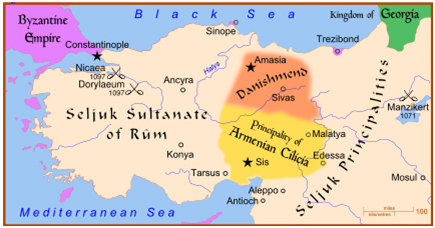2100 YEARS OR TRIBAL INVASION
400BC TO 1700AD
(See maps below how to use and where)
RISE OF THE TURKS
The Turks emerged from the Gobi Desert about 200 BC. Their migration appeared was first noted about the 6th century. Other Turk nomads from the Altai region founded the Gorturk Empire, a confederation of tribes whose influence extended from the 6th thru the 8th centuries from Aral Sea to Transoxamia. The Gorturks are known to have been enlisted by the Byzantine Emperors in the 7th century as allies against the Sassanians. In the 8th century, Turkis tribes moved south of the Oxus River while others moved west to the northern shore of the Black Sea.
THE GREAT SELJUK SULTANATE
The Turkish migrations after the 6th century were part of a general movement of peoples out of central Asia during 1st millennium AD that was influenced by a number of interrelated factors – climate, strain of growing populations on fragile pastoral economies, losses from looting and aggressive neighbors.
One branch of the Oguz tribe embracing Islam went to India, while another led by Seljuk went west and entered service with the Ahbasid Caliphs of Baghdad who were spiritual leaders of Islam as well as temporal rulers of Mesopotania, Syria and Persia.
Known as Gazis (warriors of Islamic faith), the Turkish horsemen were organized in tribal bands to defend the frontiers of the caliphate, often against their own kinsmen. In 1055 AD Seljuk Khan, Tugrul Bey (1055- 63) occupied Baghdad at the head of an army composed of Gazis and Mamluks (slave-soldiers-Circassians and Kurds.) Tugrul forced the caliph to recognize him as Sultan (temporal leader) in Persia and Mesopotania. His regime eliminated Arabs from government and relied on a staff of Persian ministers to establish what came to be known as The Great Seljuk Sultanate.
As they engaged in state-building, the Seljuks also became the champions of Sunni Islam against Shia Tugrul’s successor. The Seljuks followed the Gazis into Anatolia mainly to keep them under their control as they would be needed for military power. In 1071 Alp Arslan routed the Byzantine army at Manzikert opening all of Anatolia to conquest by the Turks.
Armenia had been annexed by Byzantine Empire in 1045, but religious enmity between the Armenians and the Greeks prevented the two Christian peoples from cooperating against the Turks on their frontier. Their homeland fell to the Seljuks
.
The Sultanate of Rum
Within 10 years, the Seljuks had won control of Anatolia. However, the Seljuk Sultanate in Baghdad was staggering under the attacks of the Mongols in the east. They were unable to defend their new territories and the Gazi carved out states while the area was overrun by Turkish immigration. The strongest state to emerge was the Seljuk Sultanate of Rum with capital at Konya. In 12th and 13th centuries, Rum gained dominance over the other Turkish states.

|

